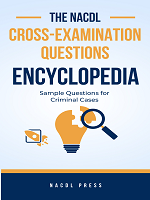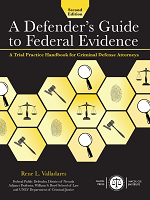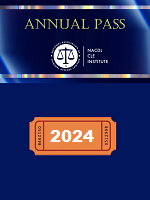Access to The Champion archive is one of many exclusive member benefits. It’s normally restricted to just NACDL members. However, this content, and others like it, is available to everyone in order to educate the public on why criminal justice reform is a necessity.
Like much of the nation, I have been transfixed with the furor over recent cases in which unarmed black men were killed by law enforcement. I am sure our membership is wondering what NACDL will do in response.1 Many of our members have views not only on these cases but on the related issues that necessarily arise from these tragic occurrences. All of these issues are important: the fair and equal treatment of all persons regardless of race, religion, gender, ethnicity, sexual orientation, disability, economic station, or other demographic characteristic; the independent criminal investigation of law enforcement officers (by prosecutors that do not oversee the same officers on a regular basis); and grand jury reform.
NACDL does not generally comment on pending investigations, as is currently the case with respect to federal investigations regarding the deaths of both Michael Brown and Eric Garner. However, for many years the Association has had concerns about the integrity of the grand jury process and the overwhelming influence of prosecutors over that process and its outcomes. Indeed, NACDL has advocated for reform of the grand jury process to ensure fundamental fairness. See NACDL’s Federal Grand Jury Reform Report & Bill of Rights (2000) and Evaluating Grand Jury Reform in Two States: The Case for Reform (2011).2
Additionally, the Association has been keenly focused in recent years on racial and ethnic disparity in the criminal justice system. In 2012 NACDL co-sponsored a conference — Criminal Justice in the 21st Century: Eliminating Racial and Ethnic Disparity in the Criminal Justice System — that culminated in the release of a report and recommendations3 and a series of academic articles published in the New York University Journal of Legislation and Public Policy. Later we produced a podcast series on racial disparity in the criminal justice system, and organized a second conference in late 2013 addressing racial and ethnic implications of money bail, the pretrial process, stop and frisk, implicit bias in charge and case disposition, sentencing, and the collateral consequences of conviction. In the aftermath of the killing of Michael Brown in Ferguson, Mo., NACDL put together a free webinar4 entitled Under Siege: The Defense Bar Examines Police Militarization, Ethnic & Racial Dynamics of Sentencing, and Their Impact on Criminal Justice Outcomes.
However, the public dialogue emanating from the loss of lives in these cases has centrally focused on race and the unfairness suffered by persons of color within the criminal justice system. Criminal defense lawyers know as much as anyone that racial injustice exists and permeates the criminal justice system at virtually every critical stage of the proceedings, from arrest, to bail, verdict, and sentencing.
This column considers a related topic that has not been the focus of a lot of public dialogue — the need to reform the grand jury system.
Television commentators and members of the print media who denigrated the failure to indict in the Brown and Garner cases advanced the adage that “a good prosecutor could get a grand jury to indict a ham sandwich.”5 These journalists did not question, at the same time, the entire grand jury system.
As repeatedly explained to the public, the “ham sandwich” refrain refers to the prosecutor’s ability to indict without any evidence. The commentators thus argued that if prosecutors can indict without any evidence, they certainly should have been able to indict these officers (or else there was a failure in the process). Perversely, this argument hoisted an utterly flawed process — and an adage that epitomizes its flawed nature — to support the arguable wrongful failure to bring an indictment.
In time, the argument enlarged to include that in reality the grand jury is but a tool of the prosecution, whether that means to indict without evidence or to fail to indict in the face of arguable evidence. Yet even as the public discourse expanded to point out that the grand jury is but a tool of the prosecutor, there was no discussion concerning the fact that the grand jury system is broken, that it has deviated from its historic duty to protect the public from the sovereign, and that it has moved away from its duty to act as a “shield” rather than a “sword.”
The grand jury system is broken not only for the racially charged case or when the potential target is law enforcement, but it is also broken when an everyday, run-of-the-mill indictment is involved.
Criminal defense lawyers know that grand juries have lost their historic function, as intended by the Fifth Amendment,6 to be an independent body to protect individuals (and corporations) from government excess and overreaching. In practice, the grand jury is largely an unrestrained, powerful tool of the prosecutor. Isn’t it time for the public to also understand this fundamental radical shift of purpose?
NACDL will begin, once again, a further robust discussion of the grand jury system. It is time for the institutional formulation and implementation of a Grand Jury Bill of Rights that will protect grand jury witnesses and potential defendants. NACDL initially advanced this idea in its 2000 report,7 but the concept is sorely in need of renewed vigor.
Here are some areas of concern that may warrant reform:
- No prosecutor should knowingly fail to disclose to the grand jury evidence in the prosecutor’s possession that exonerates the target or subject of the offense.
- The grand jurors should be given meaningful instructions, on the record, regarding their independence, duties and powers as grand jurors and the charges they are to consider. All instructions, recommendations, and commentary to grand jurors by the prosecution should be recorded and should be made available to the accused after an indictment during pretrial discovery. The court should have discretion to dismiss an indictment, with or without prejudice, in the event of prosecutorial impropriety reflected in the transcript.
- Presumptively, there must be disclosure to the defendant of all testimony taken before the grand jury.
- A witness must have sufficient reasonable notice, no less than 72 hours before any requested appearance, insuring adequate time to consult with counsel and time for counsel to properly investigate and prepare.
- Counsel for the witness must be allowed to be present alongside his or her client with the ability to support, confer, and assist.
- Witnesses should have the right to receive a transcript of their grand jury testimony.
- The target (putative defendant) and counsel must be provided notice and opportunity to testify and must be permitted to offer, in writing, to provide information or evidence to the grand jury.
The conversation regarding grand juries has begun. Now it is time to redirect it. We must examine the function and practices of today’s grand juries; the deviation from historic purpose; the fundamental flaws that have existed for too long; and the manner, method and means of incorporating a broad range of change nationwide to strive for a fairer criminal justice system.
NACDL, Amen!
Notes
- Recently, in announcing that NACDL would organize a publicly broadcast webinar on grand jury practice in America, I stated: “The rules of the road by which criminal charges are considered must be fair and transparent, and the rules must command the respect of the entire public in all cases. The recent episodes in New York and Missouri provide ample justification for a national reconsideration of the grand jury process.” Additionally, we will establish a working group to study and develop NACDL policy concerning police body cameras, including investigation and recommendations as to their use (how, when, and under what circumstances), the storage and maintenance of camera recordings, their accessibility as public records, and consideration of privacy rights.
- Go to https://www.nacdl.org/reports.
- Read the report discussing the elimination of racial and ethnic disparities at https://www.nacdl.org/reports.
- Additional information about the Under Siege webinar is available at https://www.nacdl.org/racialjustice.
- New York State Chief Judge Sol Wechsler was famously quoted in a novel that “a grand jury would indict a ham sandwich, if that’s what you wanted.” Tom Wolfe, The Bonfire of the Vanities (1987).
- The Fifth Amendment, in material part, states: “No person shall be held to answer for a capital, or otherwise infamous crime, unless on a presentment or indictment of a grand jury. …”
- Go to https://www.nacdl.org/reports.
About the Author
Theodore “Ted” Simon is an attorney in private practice in Philadelphia, Pa., where he has based a local, national, state, federal, and international trial and appellate practice representing individuals and corporations. Simon has obtained reversals in the U.S. Supreme Court and in the Pennsylvania Supreme Court. He is a leading authority on the representation of Americans abroad, extradition, and international prisoner transfer. Simon is a Trustee of the Foundation for Criminal Justice. He is also a member of the Board of Directors of Philadelphia’s Jenkins Law Library, America’s first law library.
Theodore Simon
Law Offices of Theodore Simon
1600 Market Street, 14th Floor
Philadelphia, PA 19103
215-563-5550
Fax 215-563-8798
TSimonEsq1@aol.com






